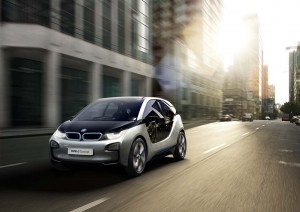
The new high-speed charging system will be available for the launch of the new Chevrolet Spark EV this year.
Along with high prices and limited range, consumers list long charging times as one of the reasons why they’re reluctant to buy battery-based vehicles, whether plug-in hybrids or pure battery-electric models.
But proponents have been hoping to see demand increase with the increased availability of high-speed, so-called Level III chargers that could trim recharging times from hours to minutes. The problem has been that, until now, manufacturers have had several different high-speed charging options to choose from and that’s held off broader adoption that could put these chargers within easy reach of consumers.
General Motors and BMW, however, have both agreed to sign on to a new standard designed to allow any battery car, whatever the brand, and whether plug-in or pure BEV, to get an 80% recharge in as little as 20 minutes. A number of other makers, including Ford, Chrysler, Daimler, Volkswagen, Audi and Porsche, have also indicated they will adopt the standard.
“This unprecedented cooperation among OEMs and equipment suppliers demonstrates the maturity of this important technology that will help speed the adoption of electric vehicles around the world,” said Britta Gross, Director, Advanced Vehicle Commercialization Policy at General Motors.
(GM slashes price to spur sales of Chevrolet Volt plug-in. Click Here.)
Currently, motorists have a choice of plugging their vehicles into standard household current, which can take the better part of a day to recharge a battery-car, or find or install a so-called Level II charger using 240 volts. These can trim charge times by more than half – though that still means leaving a vehicle plugged in for hours.
The new system adopted by the Society of Automotive Engineers, or SAE, bumps that up to 480 volts and switches from AC to DC. That eliminates the conversion to direct current that normally slows down the charging process. Equally important, the SAE has mandated a single connector design that participating automakers – and charger system suppliers – will adopt.
(Tesla plans to launch cross-continent Supercharger network. Click Herefor that story.)
The first vehicles equipped to use the new charging system will be the 2014 Chevrolet Spark EV and the BMW i3 – the latter marking the launch of an all-new battery-car brand dubbed BMW i.
Both vehicles are urban-oriented battery-electric vehicles with range of less than 100 miles per charge. While that might be considered more than enough on a typical, around-town errand or commute, studies have shown that motorists remain concerned about the occasional, longer journey that might leave them running out of power before reaching their destination.
While 20 minutes is still a lot longer than needed to fill the gas tank on a conventional automobile, advocates like Tesla Motors CEO Elon Musk insist that’s a reasonable amount of time to stop for a fast food break or to run into a grocery store or pharmacy.
Of course, that assumes that there’ll be chargers outside a McDonald’s or CVS. And that’s not quite so certain. For one thing, GM acknowledges each charger will cost anywhere from $20,000 to $30,000 apiece. Setting up enough to handle a few vehicles, then, could push into the six figures.
(Hyundai readying electric vehicle for US market. Click Here for more.)
That’s significantly more expensive than the slower, Level II chargers currently popping up around the country. But there’s the question of who would invest in the technology – and there’s the classic chicken-and-egg syndrome at work.
Several private companies are planning regional or even national high-speed charger networks, such as Texas-based eVgo. Tesla, meanwhile, recently announced plans to install 100s of so-called Supercharger stations around the country, putting most Americans within 80 to 100 miles of the Level III chargers.
But with battery-car sales lagging, it’s questionable how many others will install the new SAE-approved technology unless and until there are more of the vehicles on the road. Proponents are hoping that retailers and other businesses such as movie theater operators will come onboard as a way to attract customers.
In some cases, motorists might find these chargers available for free, in other cases they might have to pay – though the energy is expected to still be substantially less expensive, per mile, than gasoline.
(New eGallon calculator compares gas, electric costs per/mile. Click Here for more.)
Meanwhile, David Danielson, the assistant secretary for Energy Efficiency and Renewable Energy for the federal Energy Department, says the government is working with manufacturers of the new high-speed chargers to try to bring costs down. Four different vendors, ABB, Aker Wade, Eaton and IES, participated in a final test program this past week to ensure the new system was ready for the public.
GM officials say they expect at least some of the new chargers to begin showing up by the time the Chevy Spark EV goes on sale in California and Oregon later this year.



While a 20 minute “top-up charge” would definitely be useful there are several concerns.
1. How likely are these batteries to overheat with such a high recharge rate? See Boeing 787 for potential issues with L-ion batteries.
2. Who is going to pay for these fast charging systems and support?
3. Would most people with an EV drive 25+ miles out of their way to re-charge?
4. Does it make sense to drive 25+ miles out of your way to re-charge the batteris?
5. Why would people buy an EV when a Diesel engine can deliver similar cost-per-mile when the TCO is calculated and a Diesel can go anywhere, any time and usually travel 400+ miles on a single tank of fuel in addition to being maintained and serviced by countless shops nationwide?